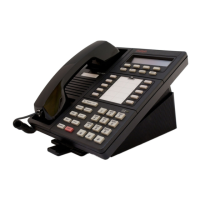MERLIN LEGEND Communications System Release 6.1
Feature Reference
555-661-110
Issue 1
August 1998
Features
Page 70Automatic Route Selection
NOTE:
In Release 6.0 and later systems (Hybrid/PBX mode only), local system
users can use ARS to access lines/trunks connected to another MERLIN
LEGEND Communications System or to a DEFINITY Enterprise
Communications Server (ECS) or DEFINITY ProLogix Solutions system.
The connection to the networked system is made by using tandem tie (T1-
emulated or analog) or tandem PRI trunks. Details about setting up and
planning this functionality are provided in “Tandem Switching” on page
671. Detailed information about private networks is included in the
Network
Reference.
Programmable lists, called
tables
, indicate the desired routes (line/trunk facilities)
for specified area codes and/or exchanges. There is a different ARS table for
each type of call (local, toll, special number, and so on). The tables are chosen
according to the telephone number digits that are dialed by a user. Each ARS
table has a particular pool to which it routes calls.
A table contains some or all of the following types of information:
■ Table Type. Indicates how to interpret the information in the table. Table
types are Area Code, Local Exchange, 6-Digit, 1 + 7, Dial 0, Special
Numbers (N11), Default Toll, and Default Local. Details for each table type
are discussed later in this section.
■ Digit Strings. Table includes 3-digit entries, usually area codes or
exchanges. Dialed digits are compared to the stored digits. A match should
occur in only one table and cause selection of the routes in that table.
■ Subpattern. An array of up to six routes. There are two subpatterns for all
tables except the Special Numbers (N11) and Dial 0 tables. The subpattern
selected depends on the time of day that the call is made and the start time
associated with each subpattern. (The start time for Subpattern A is
specified as the stop time for Subpattern B.)
The Special Numbers (N11) Table always uses the main pool and thus has
neither subpatterns nor routes. The Dial 0 Table has no subpatterns and
only one route.
■ Routes. A structure that defines possible lines/trunks to be used in a
preferred order, usually based on the lowest cost and the extension user’s
privilege level or FRL. Routes cannot be programmed for the Special
Numbers (N11) Table. A route contains the following types of information.
— Pool. A group of lines/trunks that are to be used for this route. A pool
must be programmed before any other route information.
NOTE:
If you are using data in your system, program pools, including the
default pool, for the proper data type. For example, a pool with T1
data-only lines cannot be used for voice calls. Loop-start,
ground-start, T1 voice, and some PRI lines support only voice and

